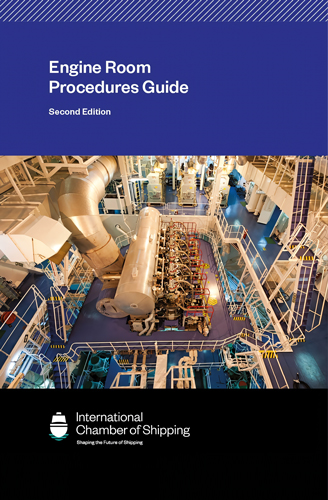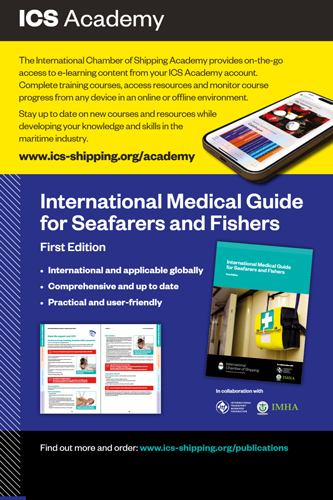Engine Room Procedures Guide/Руководство по эксплуатации машиного отделения
Книга на английском языке
В книге отсутствует страница 38
The Engine Room Procedures Guide has been developed by the International Chamber of Shipping (ICS) for use by marine engineer officers and ratings responsible for operating and maintaining engine rooms on merchant ships. The Guide, now in its second edition, is primarily intended to provide guidance for chief engineers and other members of the engineering team working on all types of ship, but it should also assist shipping companies and training institutions.
The Engine Room Procedures Guide sets out routine and emergency engine room procedures and checklists for use by the ship’s engineering team. It provides clear guidance on best practice approaches to operating and maintaining engine rooms, and all the equipment they contain, in a safe and environmentally responsible manner. The Guide embraces and promotes adherence to internationally agreed standards and is intended to complement regulations and recommendations adopted by the United Nations (UN) International Maritime Organization (IMO).
Many of the procedures outlined in this Guide are already in widespread use across the industry and may seem obvious to experienced crew. However, feedback from ICS member national shipowners’ associations suggests that incidents still occur, even during routine procedures. The aim of setting down basic procedures in a best practice guide is to further improve safety standards across the global fleet, consistent with the concept of continuous improvement which underpins the IMO International Safety Management (ISM) Code.
Since the first edition was published in 2020, the Engine Room Procedures Guide has started to enjoy a similar degree of recognition and authority as its longstanding sister publication, the widely used Bridge Procedures Guide.
This second edition of this Guide has evolved to incorporate the new technologies and procedures that the shipping industry requires to meet their decarbonisation goals. For this reason, ICS has developed new sections for ships that:
Use LNG as a fuel on non-gas carriers;
Use biofuels;
Bunker alkali; and
Carry out low load operations.
Based on lessons learned, IC3 has also updated the sections on topics including exhaust gas cleaning systems (EGCS), enclosed space entry, ballast water management, and preparing for inspections, to further improve and develop engine room team understanding.
Contents
Abbreviations
Definitions
Chapter 1 Introduction
1.1 The value of procedures
1.2 Changes in the engine room
1.3 An effective engineering team
1.4 Documentation
1.5 Environmental protection
1.6 Company policy and procedures
Chapter 2 Engineering department organisation
2.1 Chief engineer
2.2 The engineering team
2.3 Familiarisation of new crew
2.4 Role of the electro-technical officer (ETO)
Chapter 3 Engineering team management
3.1 Officer in charge of an engineering watch (EOOW)
3.2 Watchkeeping ratings
3.3 The maintenance team
3.4 The human element
3.5 Work and rest hours
Chapter 4 Communication
4.1 A common working language
4.2 Quality of communication
4.3 Briefing and debriefing
4.4 Communication with the bridge
4.5 Communication with other departments
4.6 Call for help
4.7 Radio communication
4.8 Talkback and sound-powered phones
Chapter 5 Safety of the ship
5.1 General
5.2 Regulations
5.3 Fire
5.4 Flooding
5.5 Loss of control of navigation and ship’s systems
Chapter 6 Emergency preparedness
Chapter 7 Critical operating periods
7.1 Crewing level changes
7.2 Changing watches
7.3 Manoeuvring
7.4 Security threats
7.5 Crewing in port/anchorage
7.6 Unattended machinery spaces
7.7 Emission control areas (ECAs) - fuel changeovers
7.8 Bunkering
Chapter 8 Watchkeeping
8.1 The bridge
8.2 Checklists
8.3 Situational awareness in the engine room
8.4 Alarms and actions
8.5 Periodic checks on machinery and related equipment
8.6 Periodic quality tests
8.7 Bilge and sludge management
8.8 Record keeping
8.9 Changing over the watch
Chapter 9 Pollution control
9.1 Regulations
9.2 Air emissions
9.3 Equipment operation guidelines
9.4 Environmental training
9.5 Bilge management
9.6 Responsibilities
9.7 Record keeping and reporting
Chapter 10 Machinery operation guidelines
10.1 Machinery operation manuals
10.2 Main and auxiliary engines(s)
10.3 Fuel
10.4 Gas turbines
10.5 Steam propulsion
10.6 Steering gear
10.7 The electrical power plant
10.8 Steam plant
10.9 Ancillary equipment
10.10 Energy conservation
Chapter 11 Machinery maintenance and inspection guidelines
11.1 Equipment isolation
11.2 Code of Safe Working Practices
11.3 Machinery operating and maintenance manuals
11.4 Spare parts and inventory management
11.5 Maintenance methodology
11.6 Machinery defect log
11.7 Machinery inspections
11.8 Risk assessment and permit to work
11.9 Measuring instruments
11.10 Tools
11.11 Enclosed spaces
11.12 Hot work
11.13 Harmful substances
11.14 Essential engine room seamanship
Chapter 12 Ship-type specific guidelines
12.1 Oil, gas and chemical tankers
12.2 Dynamic positioning (DP) ships
12.3 Passenger ships
Chapter 13 Preparing for inspections
13.1 Introduction
13.2 The role of the chief engineer and the engineering team
13.3 Common areas that are inspected in the engine room
13.4 Common inspection deficiencies
13.5 Crew related factors for deficiencies




